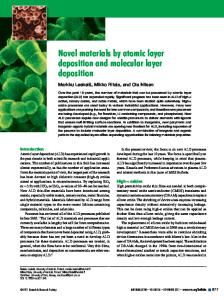In-Situ Infrared Absorption Monitoring of Atomic Layer Deposition of Metal Oxides on Functionalized Si and Ge Surfaces
- PDF / 383,972 Bytes
- 6 Pages / 612 x 792 pts (letter) Page_size
- 60 Downloads / 311 Views
0996-H07-04
In-Situ Infrared Absorption Monitoring of Atomic Layer Deposition of Metal Oxides on Functionalized Si and Ge Surfaces Min Dai1, Jinhee Kwon1, Ming-Tsung Ho1, Yu Wang1, Sandrine Rivillon2, Meng Li1, Yves Jean Chabal2, and Marek Boleslawski3 1 Physics and Astronomy, Rutgers University, Laboratory for Surface Modification, 136 Frelinghuysen Road, Piscataway, NJ, 08854 2 Chemistry and Chemical Biology, Rutgers University, Laboratory for Surface Modification, 136 Frelinghuysen Road, Piscataway, NJ, 08854 3 SAFC Hitech, 5485 County Road V, Sheboygan Falls, WI, 53085 ABSTRACT The nature of the interface between Si and Ge substrates and high-k dielectrics often controls the performance of MOSFET devices. Precleaning and/or chemical functionalization of the surfaces can dramatically affect the formation of an interfacial layer. We have used in-situ IR spectroscopy to probe the relevant interfaces during ALD growth for a variety of surface treatments, including H- and Cl-termination, and nitridation. This paper focuses on understanding of the mechanisms for interfacial SiO2 (or GeOx) formation during HfO2 growth using tetrakis-ethylmethylamidohafnium (TEMAH) as the metal precursor and water or ozone as the oxygen precursor. We find that impurities arising from incomplete ligand elimination during growth (e.g. OH for H2O processing and CO- and NO-containing species for O3 processing) are incorporated into the HfO2 film during growth. Upon annealing, most of these species react, but can also migrate to the interface. Nitridation of Si and Ge surfaces will in general prevent SiO2 or GeOx formation but can also affect the growth rate. INTRODUCTION As conventional SiO2/Si-based MOSFETís are facing the fundamental limit of scaling, replacement of SiO2 by high-permittivity (k) dielectric materials is imminent for future CMOS performance enhancements [1]. High-k dielectric candidates must satisfy stringent requirements such as large band gap and band offset, good thermodynamic stability with Si, low defect density (high-quality interface) and equivalent oxide thickness (EOT) of at most 10 ≈ [2]. It is challenging to achieve a thin EOT because of interface layer formation between Si substrate and high-k dielectric which has lower permittivity. Another obstacle lies in degradation of carrier mobility at the silicon substrate and high-k interface [3]. Thus search for further evolution of the gate stack raises interest for high carrier mobility substrates such as Ge and III-V semiconductors as channel layers [4]. We used atomic layer deposition (ALD) to grow thin HfO2 films on Si and Ge to investigate mechanisms of interfacial oxide formation and overall film properties. ALD deposits ultra-thin films layer by layer, thus offering control over the thickness and uniformity of films in the atomic range [5]. Since the initial stage of Si (or Ge)/high-k interface formation affects the structure and composition of the films, and eventually the electronic performance of devices, understanding the interface nucleation mechanisms is
Data Loading...










